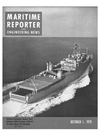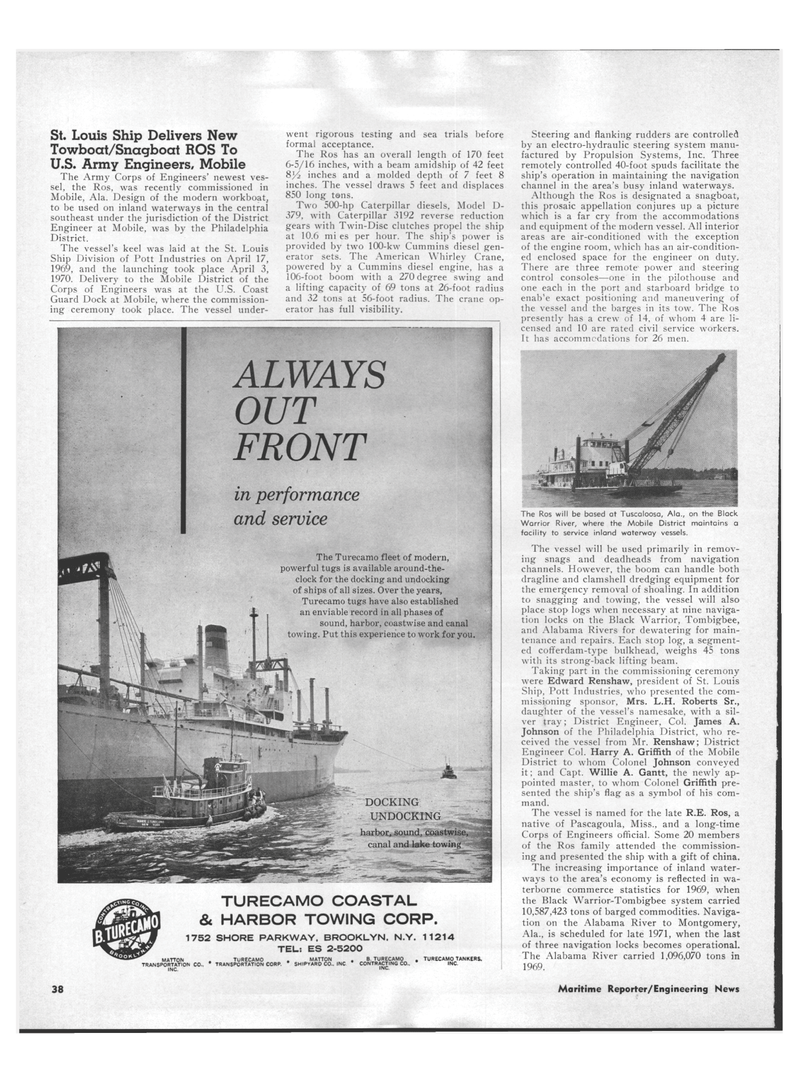
Page 36: of Maritime Reporter Magazine (October 1970)
Read this page in Pdf, Flash or Html5 edition of October 1970 Maritime Reporter Magazine
St. Louis Ship Delivers New
Towboat/Snagboat ROS To
U.S. Army Engineers, Mobile
The Army Corps of Engineers' newest ves- sel, the Ros, was recently commissioned in
Mobile, Ala. Design of the modern workboat, to be used on inland waterways in the central southeast under the jurisdiction of the District
Engineer at Mobile, was by the Philadelphia
District.
The vessel's keel was laid at the St. Louis
Ship Division of Pott Industries on April 17, 1969, and the launching took place April 3, 1970. Delivery to the Mobile District of the
Corps of Engineers was at the U.S. Coast
Guard Dock at Mobile, where the commission- ing ceremony took place. The vessel under- went rigorous testing and sea trials before formal acceptance.
The Ros has an overall length of 170 feet 6-5/16 inches, with a beam amidship of 42 feet inches and a molded depth of 7 feet 8 inches. The vessel draws 5 feet and displaces 850 long tons.
Two 500-hp Caterpillar diesels, Model D- 379, with Caterpillar 3192 reverse reduction gears with Twin-Disc clutches propel the ship at 10.6 mi es per hour. The ship's power is provided by two 100-kw Cummins diesel gen- erator sets. The American Whirley Crane, powered by a Cummins diesel engine, has a 106-foot boom with a 270 degree swing and a lifting capacity of 69 tons at 26-foot radius and 32 tons at 56-foot radius. The crane op- erator has full visibility.
Steering and flanking rudders are controlled by an electro-hydraulic steering system manu- factured by Propulsion Systems, Inc. Three remotely controlled 40-foot spuds facilitate the ship's operation in maintaining the navigation channel in the area's busy inland waterways.
Although the Ros is designated a snagboat, this prosaic appellation conjures up a picture which is a far cry from the accommodations and equipment of the modern vessel. All interior areas are air-conditioned with the exception of the engine room, which has an air-condition- ed enclosed space for the engineer on duty.
There are three remote- power and steering control consoles—one in the pilothouse and one each in the port and starboard bridge to enab'e exact positioning and maneuvering of the vessel and the barges in its tow. The Ros presently has a crew of 14, of whom 4 are li- censed and 10 are rated civil service workers.
It has accommodations for 26 men.
The Ros will be based at Tuscaloosa, Ala., on the Black
Warrior River, where the Mobile District maintains a facility to service inland waterway vessels.
The vessel will be used primarily in remov- ing snags and deadheads from navigation channels. However, the boom can handle both dragline and clamshell dredging equipment for the emergency removal of shoaling. In addition to snagging and towing, the vessel will also place stop logs when necessary at nine naviga- tion locks on the Black Warrior, Tombigbee, and Alabama Rivers for dewatering for main- tenance and repairs. Each stop log, a segment- ed cofferdam-type bulkhead, weighs 45 tons with its strong-back lifting beam.
Taking part in the commissioning ceremony were Edward Renshaw, president of St. Louis
Ship, Pott Industries, who presented the com- missioning sponsor, Mrs. L.H. Roberts Sr., daughter of the vessel's namesake, with a sil- ver tray; District Engineer, Col. James A.
Johnson of the Philadelphia District, who re- ceived the vessel from Mr, Renshaw; District
Engineer Col. Harry A. Griffith of the Mobile
District to whom Colonel Johnson conveyed it; and Capt. Willie A. Gantt, the newly ap- pointed master, to whom Colonel Griffith pre- sented the ship's flag as a symbol of his com- mand.
The vessel is named for the late R.E. Ros, a native of Pascagoula, Miss., and a long-time
Corps of Engineers official. Some 20 members of the Ros family attended the commission- ing and presented the ship with a gift of china.
The increasing importance of inland water- ways to the area's economy is reflected in wa- terborne commerce statistics for 1969, when the Black Warrior-Tombigbee system carried 10,587,423 tons of barged commodities. Naviga- tion on the Alabama River to Montgomery,
Ala., is scheduled for late 1971, when the last of three navigation locks becomes operational.
The Alabama River carried 1,096,070 tons in 1969.
ALWAYS
OUT
FRONT in performance and service
The Turecamo fleet of modern, powerful tugs is available around-the- clock for the docking and undocking of ships of all sizes. Over the years,
Turecamo tugs have also established an enviable record in all phases of sound, harbor, coastwise and canal towing. Put this experience to work for you.
DOCKING
UNDOCKING harbor, sound, coastwise, canal and lake towing
TURECAMO COASTAL & HARBOR TOWING CORP. 1752 SHORE PARKWAY. BROOKLYN. N.Y. 11214
TEL.: ES 2-5200
MATT0N TRANSPORTATION CO.,
INC.
TURECAMO
TRANSPORTATION CORP.
MATTON
SHIPYARD CO.. INC
B. TURECAMO
CONTRACTING CO..
INC
TURECAMO TANKERS.
INC. 38 Maritime Reporter/Engineering News

 35
35

 37
37
